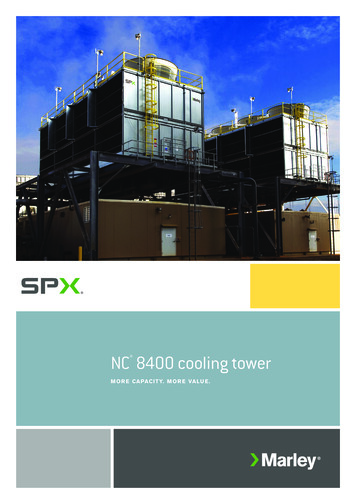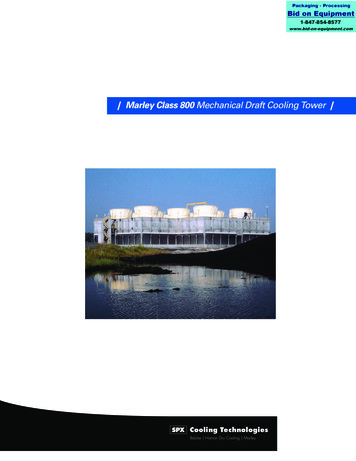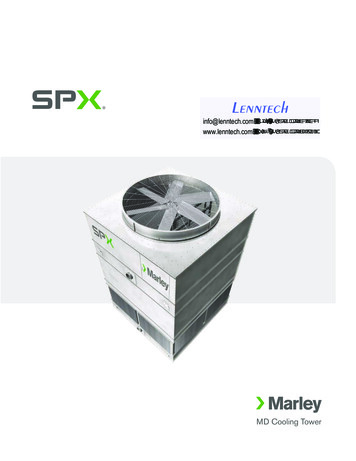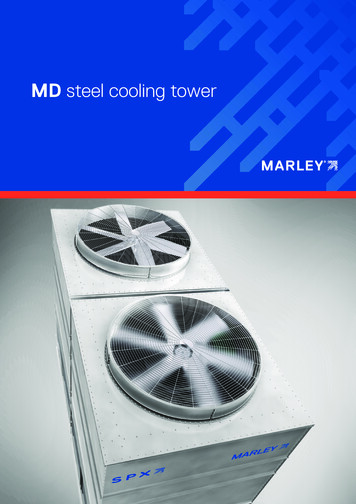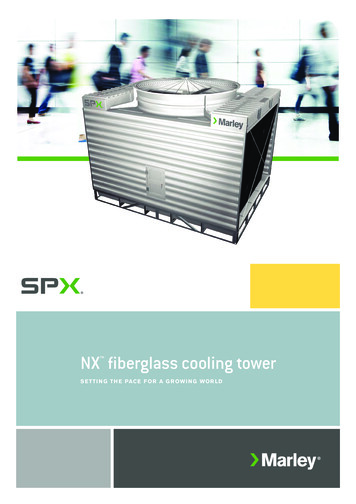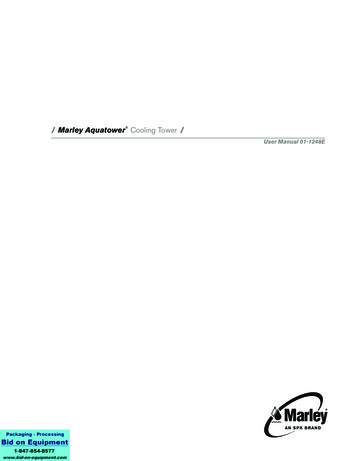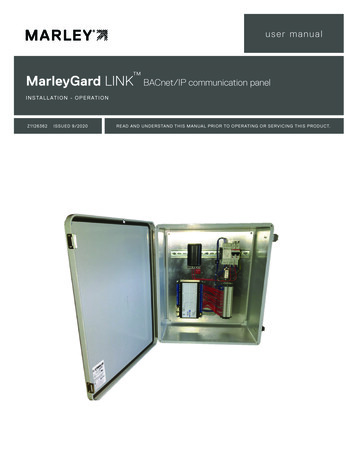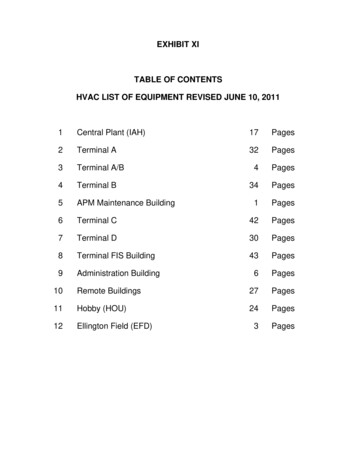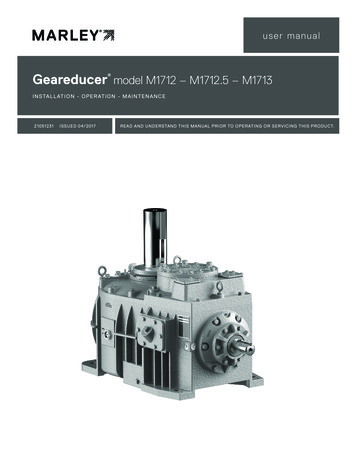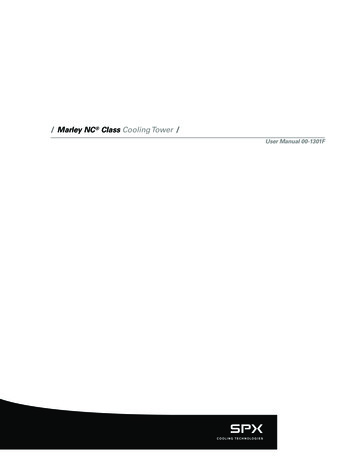
Transcription
/ Marley NC Class Cooling Tower /User Manual 00-1301F
ContentsNoteThis manual contains vital information for the proper installation andoperation of your cooling tower. Carefully read the manual beforeinstallation or operation of the tower and follow all instructions. Savethis manual for future reference.Tower Location. 5Tower Shipment. 5Receiving Tower. 5Hoisting Tower. 5Tower Installation. 6Tower Start-Up. 13Tower Operation. 15Wintertime Operation. 17Water Treatment and Blowdown. 19Cooling Tower Cleaning. 21Schedule of Tower Maintenance. 24Motor Relubrication Instructions. 26Seasonal Shutdown Instructions. 27Prolonged Shutdown. 28Maintenance Schedule. 29Troubleshooting. 30Additional Information. 32The following defined terms are used throughout this manual to bring attention to the presence of hazards of various risk levels, or to importantinformation concerning the life of the product.WarningIndicates presence of a hazard which can cause severe personalinjury, death or substantial property damage if ignored.CautionIndicates presence of a hazard which will or can cause personal injuryor property damage if ignored.Note2Indicates special instructions on installation, operation or maintenancewhich are important but not related to personal injury hazards.
PreparationThe Marley NC Class cooling tower purchased for this installation represents the current state of the art in crossflow, induced draft cooling towerdesign. Thermally and operationally, it is the most efficient cooling towerof its class.These instructions—as well as those offered separately on motors, fans,Geareducers , couplings, drive shafts, float valves, etc.—are intended toassure that the tower serves you properly for the maximum possible time.Since product warrantability may well depend upon your actions, pleaseread these instructions thoroughly prior to operation.If you have questions about the operation and/or maintenance of thistower, and you don’t find the answers in this manual, please contact yourMarley sales representative. When writing for information, or when ordering parts, please mention tower serial number shown on the nameplatelocated on the access door.Safety FirstThe location and orientation of the cooling tower can affect the safety ofthose responsible for installing, operating or maintaining the tower. However, since SPX Cooling Technologies does not determine the location ororientation of the tower, we cannot be responsible for addressing thosesafety issues that are affected by the tower’s location or orientation.WarningWarningThe following safety issues should be considered by those responsiblefor designing the tower installation. access to and from the fan deck access to and from maintenance access doors the possible need for ladders (either portable or permanent) togain access to the fan deck or maintenance access doors the possible need for handrails around the fan deck the possible need for external access platforms potential access problems due to obstructions surrounding thetower lockout of mechanical equipment the possible need for safety cages around ladders t he need to avoid exposing maintenance personnel to the potentially unsafe environment inside the tower.3
PreparationThose are only some of the safety issues that may arise in the designprocess. SPX strongly recommends that you consult a safety engineerto be sure that all safety considerations have been addressed.Several options are available that may assist you in addressing some ofthese personnel safety concerns, including:— a handrail system around the perimeter of the fan deck with either oneor two ladders for access to the deck— ladder extensions (used where the base of the tower is elevated)— safety cages for fan deck ladders— external lube lines— fan cylinder extensions— flow control/balancing valves— access door platform— motor located outside the tower— external motor access platformTower LocationSpace available around the tower should be as generous as possible topromote ease of maintenance—and to permit freedom of airflow into andthrough the tower. If you have questions about the adequacy of the available space and the intended configuration of the tower, please contactyour Marley sales representative for guidance.Prepare a stable, level support foundation for the tower, utilizing weight,wind load, and dimensional information appearing on appropriate Marleysubmittal drawings. Supports must be level to insure proper operation ofthe tower.Warning4The cooling tower must be located at such distance and direction toavoid the possibility of contaminated tower discharge air being drawninto building fresh air intake ducts. The purchaser should obtain theservices of a Licensed Professional Engineer or Registered Architectto certify that the location of the tower is in compliance with applicable air pollution, fire, and clean air codes.
Receiving and HoistingTower ShipmentUnless otherwise specified, NC Class towers ship by truck (on flat bedtrailers), which lets you receive, hoist, and install the tower in one continuous operation. Single-cell towers ship on one truck. Multicell towers,depending on their size, may require more than one truck.Responsibility for the condition of the tower upon its arrival belongs to thetrucker—as does the coordination of multiple shipments, if required.Receiving TowerPrior to unloading the tower from the delivering carrier, inspect the shipment for evidence of damage in transit. If damage is apparent, note thefreight bill accordingly. This will support your future recovery claim.Find and remove the installation instruction drawings and bills of materiallocated in a plastic bag in the cold water basin. This information shouldbe kept for future reference and maintenance purposes.Hoisting TowerNC8310, NC8311, and NC8312 models consist of two modules per cell.The upper module includes hoisting clips at the top of the module. Thehoisting clips on the lower module are located near the bottom on thesides of the cold water basin. All other models ship in a single module.CautionNC upper and lower modules must be hoisted and set separately. Donot preassemble modules prior to hoisting.The hoisting clips for NC8308 and NC8309 are located near the bottomof the tower on the cold water basin sides. The hoisting clips for all othermodels are located at the top of the tower. A Hoisting-Installation labelwhich has hoisting dimensional information is located on the side casingnear the tower centerline. Remove tower from the carrier and hoist intoplace according to the instructions on the label.WarningHoisting clips are provided for ease of unloading and positioningtower. For overhead lifts or where additional safety is required, safetyslings should also be placed under the tower. Under no circumstancesshould you combine the top and bottom modules of modular modelsand attempt to hoist them at the same time by utilizing the hoistingclips alone!5
InstallationTower InstallationNoteThese installation instructions are intended to help you prepare beforeyour tower arrives. If discrepancies exist between these instructionsand those shipped with the tower, the instructions shipped with thetower will govern.1. Prior to placement of the tower, confirm that the supporting platformis level, and that the anchor bolt holes are correctly located in accordance with Marley drawings.2. Place tower (or bottom module of NC8310, NC8311 and NC8312 models) on your prepared supports, aligning anchor bolt holes with those inyour supporting steel. Make sure that the orientation agrees with yourintended piping arrangement. Attach tower to supporting steel with four5/8″ (16 mm) diameter bolts and flat washers (by others). Position flatwashers between the bolt head and the tower basin flange.3. NC8310, NC8311, and NC8312 models only. Before setting top modulein place on bottom module, clean any debris from the underside of thetop module fill, skid and beams and from the top of the bottom module and remove shipping cover from bottom of top module—replacefasteners at side of module to prevent leaks. Place top module on thetop peripheral bearing surface (factory-installed gasket) of bottommodule, aligning mating holes as it is set in place. (Make sure that theorientation of the top module agrees with your intended piping arrangement. Sections are 180 reversible with respect to each other.) Attachtop module to bottom module with fasteners provided—according to“NC Field Installation Manual” Assembly Instructions.If tower purchased is one fan cell only, ignore steps 4 through 8.4. If collection basins are to be equalized by the use of Marley standardflumes, unbolt the coverplate from the basin of the cell just installed.The coverplate is located in the center of the basin side.5. Unbolt temporary coverplate from the basin of the 2nd cell and set2nd cell (or bottom module of 2nd cell) in place. Align anchor boltholes and flume openings in basin sides.6. Install flume according to Field Installation Manual instructions.Note6It is important that the cells be firmly anchored before the flume isattached to the 2nd cell.
Installation7. Repeat steps 2 and 3 for 2nd top section on NC8310, NC8311, andNC8312 models.8. Repeat steps 4 through 7 for any remaining cells.9. Attach your cold water supply piping to the cold water basin outletconnection in accordance with drawing instructions, utilizing gasketsprovided.CautionDo not support your pipe from the tower or outlet connection—supportit externally.Normally, one of the following three outlet arrangements is provided:Side suction connection: This is a factory-installed, galvanized pipenipple, extending horizontally from the side of the cold water basin. Itis both beveled for welding—and grooved for a mechanical coupling.If a weld connection is used, it is recommended that the weld area beprotected against corrosion. Cold galvanizing is suggested, appliedaccording to the manufacturer’s instructions.Bottom outlet connection: This is a factory-installed, circular openingin the cold water basin floor of one or more cells. An appropriatelysized circular opening has been drilled to accept a 125# ANSI B16.1flat-face flange connection.Side outlet sump connection: Unless otherwise specified, sumpsare manufactured of heavy duty FRP (fiber-reinforced polyester) construction. Because of their size, they are attached upside down in thebasin to prevent damage in shipment. They must be inserted into thesquare opening prepared in the floor of the cold water basin of one ormore cells—sealed against leakage, and attached by machine bolts,according to the installation drawing included. An appropriately-sizedcircular opening in the vertical face of the sump has been drilled toaccept a 125# ANSI B16.1 flat-face flange connection.10. Attach makeup water supply piping to appropriately-sized float valveconnection located in cold water basin side wall. Install the drain andoverflow according to the “NC Field Installation Manual” AssemblyInstructions. If you wish to pipe overflow and drain water to a remotedischarge point, make those connections at this time also.11. Attach your warm water return piping to the inlet connections of thetower.7
InstallationNoteCautionFasteners and components provided by others that are to be attachedto the tower must be compatible with the cooling tower materials—i.e. fasteners in a stainless steel cold water basin must be stainlesssteel.Except for the horizontal components of top-mounted piping, and asprescribed on Marley drawings, do not support your pipe from thetower or inlet connection—support it externally.Normally, one of the following four inlet arrangements is provided:Standard distribution basin connections: These are circularopenings–two per cell–in the top deck of the tower near the air inletface, drilled to accept standard 125# flat-face flanges. Remove thecenter section of the inlet flume assembly to gain access to attachinlet fasteners. (Refer to “NC Field Installation Manual” shipped withtower.)Marley flow-control valve connections (option): Marley flow-controlvalves–two per cell–are designed to 1–take the place of the standardelbows normally required for inlet connection, and 2–provide meansof regulating flow to both sides of the tower. Remove the center inletflume assembly to gain access for attachment of valves. (Refer to“NC Field Installation Manual” Assembly Instructions shipped withtower.) Valves provide a vertical face for attachment of your standard125# flange.Side inlet connection (option): An appropriately sized hole and boltcircle–one per cell–is provided in the endwall casing above the access door. Bolt circle is designed to accept a standard 125# flat-faceflange.Bottom inlet connection (option): An appropriately sized hole andbolt circle–one per cell–is provided in the floor of the cold water basin.Bolt circle is designed to accept a standard 125# flat-face flange.12. Wire motor in accordance with wiring diagram.Warning8For maintenance/safety purposes, SPX recommends a lockout typedisconnect switch for all mechanical equipment. In addition to adisconnect switch, the motor should be wired to main power supplythrough short circuit protection, and a magnetic starter with overloadprotection.
InstallationMotor WiringWire motor leads as shown on the motor nameplate matching the supplyvoltage. Do not deviate from the motor nameplate wiring.Either of following symbols may be shown on the motor nameplate –Δ, Δ Δ, Y, or YY. These symbols represent how the motor is constructed onthe inside and in no way have anything to do with a Delta or Wye electricaldistribution system serving the motor.When using a starter: Set motor overload protection to 110% of motor nameplate amps.This setting allows the fan motor to operate during cooler weather.During cooler weather it is common for the motor to draw 6 to10% higher than nameplate amps. High amps are common duringtower commissioning when the tower is dry and the ambient airtemperature is cool. Do not start the motor more than six times per hour. Short cyclingthe tower will cause fuses, breakers or O.L.s to operate and willdecrease motor life.When using a two-speed starter: Motor rotation must be the same at slow speed and high speed. Single winding motor requires a starter with a shorting contactor. Two-winding motor requires a starter with out a shorting contactor. All two-speed starters must have a 20 second time delay relaywhen switching from high speed to low speed. Do not start the motor more than six times per hour (each lowspeed start and each high speed start count as one start).When using a VFD:NoteBefore beginning, ensure that the motor is rated for “Inverter Duty”per NEMA MG-1, part 31. Set the VFD solid state overload protection to 119% of motornameplate amps and set “maximum current parameter” in theVFD to motor nameplate amps. “Maximum current parameter” willreduce fan speed and limit amp draw to nameplate amps duringcold weather operation. If furnished with a mechanical O.L. set thisat 110% over motor nameplate amps. Motor rotation must be the same in both VFD mode and By-passmode.9
Installation If cable distance between the VFD and motor is greater than 100feet a DV/DT output filter is recommended to avoid damage to themotor. 100 feet distance is based on our field experience, the VFDmanufacture may state different distances and distance does varydepending on the VFD manufacture. Program the VFD for variable torque output. Flux vector and constant torque modes may damage the gearbox. Do not start and stop the motor using the safety switch at the motor.If the drive is being commanded to run and the load side is cycledON and OFF with the safety switch this may damage the VFD.Using a VFD in cooling applications has advantages over traditional singleor two speed motor control. A VFD can reduce the cost of electrical energy being used and provide better temperature control. In addition, itreduces the mechanical and electrical stress on the motor and mechanicalequipment. Electrical savings can be large during periods of low ambienttemperature when the cooling requirement can be satisfied at reducedspeeds. To benefit from these advantages, it is important that the drivebe installed correctly.Marley supplies VFD and VFD controls specifically designed for our coolingproducts. If you have purchased a Marley VFD and/or controls package,please follow the instructions in the User Manual for that system. MostVFD problems can be avoided by purchasing the Marley drive system. Ifyou are installing a VFD other than the Marley drive, please refer to thatdrives installation manual.WarningWarning10Improper use of a VFD may cause damage to equipment or personalinjury. Failure to correctly install the VFD drive will automatically voidall warranties associated with the motor and any equipment that iseither electrically or mechanically (directly) attached to the VFD drivesystem. The length of this warranty avoidance will be contingent onproperly installing the VFD system and repairing any damage thatmay have occurred during its operation. SPX Cooling Technologiesdoes not assume responsibility for any technical support or damagesfor problems associate with non-Marley brand VFD systems.Changing the operational fan speed from the factory settings couldcause the fan to operate in an unstable region which may result indamage to the equipment and possible injury.
InstallationMechanical Equipment:WarningAlways shut off electrical power to the tower fan motor prior toperforming any maintenance on the tower. Any electrical switchesshould be locked out and tagged out to prevent others from turningthe power back on.1. If equipped, check oil level in accordance with the Geareducer UserManual for the Geareducer. (Although the Geareducer was filled to theproper level at the factory, tipping during shipment and hoisting mayhave caused some loss of oil.) If oil is required, fill Geareducer to theproper level with approved lubricant. (See Geareducer User Manual )Check oil level at the Geareducer or dipstick (standpipe located on fandeck, if so equipped) to confirm that the proper level is indicated.2. Install top fan ring and fan guard according to the installation drawingshipped with the tower. NC8301 through NC8303 models include asingle-piece fan guard. NC8304 through NC8312 models include atwo-piece fan guard. Models with extended velocity-recovery cylindersdo not have fan guards.WarningImproper installation of the fan cylinder and fan guard will destroy thestructural integrity of the fan guard. Failure of the fan guard could allowoperating or maintenance personnel to fall into the rotating fan.3. Spin the fan manually to assure that all fan blades properly clear theinside of the fan cylinder. Observe the action of the coupling (or driveshaft couplings) to be sure that the motor and Geareducer are properlyaligned. If necessary, correct the alignment in accordance with theincluded manual.For Power Belt Drive equipped models observe the action of the sheavesand belts to be sure that the motor is properly aligned with the fansheave. See Belt Tensioning and Sheave Alignment on page 23.CautionIt is essential that the fan cylinder and fan guard be installed in accordance with the Field Installation Manual shipped with the tower.Do not force the fan cylinder out of round.11
Installation4. Momentarily bump (energize) the motor and observe rotation of thefan. The fan should rotate in a counterclockwise direction when viewedfrom below. If rotation is backwards, shut off the fan and reverse twoof the three primary leads supplying power to the motor.CautionIf tower is equipped with a two-speed motor, check for proper rotation at both speeds. Check also to see that starter is equipped with a20 second time delay which prevents direct switching from highspeed to low speed. If the fan is intended to be reversed for deicingpurposes, make sure that the starter is equipped with a 2 minutetime delay between changes of direction. These delays will preventabnormal stress from being applied to the mechanical equipmentand the electrical circuit components.5. Run the motor and observe the operation of the mechanical equipment. Operation should be stable, and there should be no evidence of oil leakage.6. If equipped with belt drive check the torque on the fan and motorsheave after 10 to 60 hours of operation. See Bushing Fastener TorqueValues on page 23.Note12If the water supply system is not being operated—or if there is noheat load on the system—motor amps read at this time may indicatean apparent overload of as much as 10–20%. This is because of theincreased density of unheated air flowing through the fan. Determination of an accurate motor load should await the application of thedesign heat load.
InstallationTower Start-UpWarningAmong other sources, outbreaks of Legionnaires’ Disease havereportedly been traced to cooling towers. Maintenance and watertreatment procedures that prevent amplification and disseminationof Legionella and other airborne bacteria should be formulated andimplemented BEFORE systems are operated and continued regularlythereafter to avoid the risk of sickness or death.Water System:1. New installations should be cleaned and treated with biocides by awater treatment expert before startup.2. Remove any and all accumulated debris from tower. Pay particularattention to inside areas of cold water basin, hot water basins, louversand drift eliminators. Make sure that cold water suction screens areclear and properly installed.3. Fill the water system to an approximate depth of 7″ (178 mm) in thedepressed area of the cold water basin at the center of the tower.For models NC8307 through NC8312 fill the water system to an approximate depth of 8″ (203 mm). This is the recommended operatingwater level. Adjust the float valve so that it is 75% open at that level.Continue filling the system until the water reaches a level approximately1/8″ (3 mm) below the lip of the overflow.NoteIf tower is equipped with a standard side-suction connection, ventaccumulated air from the top of the suction hood by removing one orboth tap screws provided at that location. Replace these tap screwswhen venting is complete. (On certain models, the top of the suction hood for 14″ (356 mm) diameter side suctions is 1 1/4″ (32 mm)above the top of the overflow. In those situations, it is necessary toblock the overflow and continue filling the basin to the level wherethe aforementioned tap screws are submerged before venting.)4. Completely open all hot water flow control valves. Start your pump(s)and observe system operation. Since the water system external to thetower will have been filled only to the level achieved in the cold waterbasin, a certain amount of “pump-down” of the basin water level willoccur before water completes the circuit and begins to fall from the13
Installationfill. The amount of initial pump-down may be insufficient to cause thefloat valve to open. However, you can check its operation by pressingdown on the operating lever to which the stem of the float valve isattached.Some trial and error adjustment of the float valve may be required tobalance the makeup water with tower operation. Ideally, the float valvesetting will be such that no water is wasted through the overflow atpump shutdown. However, the water level after pump start-up mustbe deep enough to assure positive pump suction.5. If the tower is equipped with flow-control valves, adjust them toequalize hot water depth in the distribution basins after reachingdesign water flow rate. Each basin should have from 3″ to 5 1/2″(76 mm to 140 mm) water depth, with uniform depth from basin tobasin. Fix valves in this position with the locking bar when depth iscorrect. Failue to tighten the locking bar after valve adjustment mayresult in damage to the valve. If the tower is equipped with the Marleyinternal piping option, the basins are self-balancing and this step isnot necessary.Uniform distribution depth of 3″ to 5 1/2″ (76 mm to 140 mm) is essentialto efficient tower operation. Contact your Marley sales representativeif you are considering a permanent change in circulating water flowrate that would prevent operation within these limits.6. Continue pump operation for about 15 minutes, after which it is recommended that the water system be drained, flushed, and refilled.7. While operating the condensing water pump(s) and prior to operating the cooling tower fan, execute one of the two alternative biocidaltreatment programs described in the following: Resume treatment with the biocide which had been used priorto shutdown. Utilize the services of the water treatment supplier.Maintain the maximum recommended biocide residual (for thespecific biocide) for a sufficient period of time (residual and timewill vary with the biocide) to bring the system under good biologicalcontrolor Treat the system with sodium hypochlorite to a level of 4 to 5 mg/L(ppm) free chlorine residual at a pH of 7.0 to 7.6. The chlorine residual must be held at 4 to 5 mg/L (ppm) for six hours, measurablewith standard commercial water test kits. 14
OperationIf the cooling tower has been in operation and then shut down for aduration of time and not drained, perform one of the two previousbiocidal treatment programs directly to the cooling water storagevessel (cooling tower sump, drain down tank, etc.) without circulating stagnant water over the cooling tower fill or operating the coolingtower fan.After biocidal pretreatment has been successfully completed, coolingwater may be circulated over the tower fill with the fan off.When biocidal treatment has been maintained at a satisfactory level forat least six hours, the fan may be turned on and the system returnedto service. Resume the standard water treatment program, includingbiocidal treatment.Tower OperationGeneral:The cold water temperature obtained from an operating cooling tower willvary with the following influences:1. Heat load: With the fan in full operation, if the heat load increases,the cold water temperature will rise. If the heat load reduces, the coldwater temperature will reduce.Note that the number of degrees (“range”) through which the towercools the water is established by the system heat load and the amountof water being circulated, in accordance with the following formula:Range – F Heat Load (Btu/hr)GPM x 500The cooling tower establishesthe cold water temperature attainor — in SIonlyunitsable under any operating circumstance.Heat Load (kilowatts)2. Air wet-bulbtemperature:Range– C Cold water temperature will also vary withLiters/secx 4.187the wet-bulb temperature of theair enteringthe louvered faces ofthe tower. Reduced wet-bulb temperatures will result in colder watertemperatures. However, the cold water temperature will not vary to thesame extent as the wet-bulb. For example, a 20 F (11 C) reductionin wet-bulb may result in only a 15 F (8 C) reduction in cold watertemperature.3. Water flow rate: Increasing the water flow rate (GPM or L/s) will causea slight elevation in cold water temperature, while reducing the waterflow rate will cause the cold water temperature to decrease slightly.15
OperationHowever, at a given heat load (see formula above), water flow reductions also cause an increase in the incoming hot water temperature.Use care to prevent the hot water from exceeding 125 F, (52 C) inorder to prevent damage to the tower components.4. Air flow rate: Reducing air flow through the tower causes the coldwater temperature to rise. This is the approved method by which tocontrol leaving water temperature.If your tower is equipped with a single-speed motor, the motor maybe shut off when the water temperature becomes too cold. This willcause the water temperature to rise. When the water temperature thenbecomes too warm for your process, the motor can be restarted.CautionWhen operating in this mode care must be taken not to exceed a totalacceleration time of 30 seconds per hour.Fan cycling limits: From a dead stop, determine the number of seconds it takes the fan to arrive at full speed. Divide this number into 30to determine the allowable number of starts per hour. Considering thenormal fan and motor sizes utilized on NC Class towers, anticipatethat approximately 4 to 5 starts per hour are allowable.If your tower is equipped with a two-speed motor, you will enjoy greateropportunity for temperature control. When the water temperaturebecomes too cold, switching the fan to half-speed will cause the coldwater temperature to rise—stabilizing at a tempera
The Marley NC Class cooling tower purchased for this installation repre-sents the current state of the art in crossflow, induced draft cooling tower design. Thermally and operationally, it is the most efficient cooling tower of its class. These instructions—as well as those offered separately on motors, fans,
